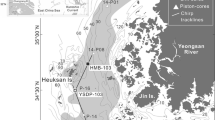Abstract
The riverine mud that escapes retention in the estuaries and enters the Gulf of Papua appears to be transported southeastward, across depth contours, by the prevailing currents in a series of wind-driven events. The mud deposits to the southeast of the rivers, at the mid-shelf region within a depth range of 40–60 m. Mud transported farther eastward is carried down the continental rise. Coarser riverine sediment (silt and sand) is deposited closer inshore. On the outer shelf (depth >60 m) relict carbonate debris dominates. The area of mud has maximum rates of pelagic and benthic productivity in the gulf.
Similar content being viewed by others
References
Alongi DM (1995) Decomposition and recycling of organic matter in muds of the Gulf of Papua, northern Coral Sea. Continental Shelf Research 15:1319–1337
Alongi DM and Robertson AI (1995) Factors regulating benthic food chains in tropical river deltas and adjacent shelf areas. Geo-Marine Letters 15:145–152
Alongi DM, Christoffersen P, Tirendi F, and Robertson AI (1992) The influence of freshwater and material export on sedimentary facies within the Fly delta and adjacent Gulf of Papua (Papua New Guinea). Continental Shelf Research 12:287–326
Bird MI, Brunskill GJ, and Chivas AR (1995) Carbon-isotope composition of sediments from the Gulf of Papua. Geo-Marine Letters 15:153–159
Curtin TB and Legeckis RV (1986) Physical observations in the plume region of the Amazon River during peak discharge—I. Surface variability and II. Water Masses. Continental Shelf Research 6:31–71
Geyer WR, Beardsley RC, Candela J, Castro BM, Legeckis RV, Lentz SJ, Limeburner R, Miranda L, and Trowbridge JH (1991) The physical oceanography of the Amazon outflow. Oceanography 4:8–14
Gibbs RJ and Konwar L (1986) Coagulation and settling of Amazon River suspended sediment. Continental Shelf Research 6:127–149
Gwyther D (1982) Yield estimates for the banana prawn (Penaeus merguiensis de Man) in the Gulf of Papua. Journal du Conseil 40:245–258
Harris PT, Baker EK, Cole AR, and Short SA (1993) A preliminary study of sedimentation in the tidally dominated Fly River delta, Gulf of Papua. Continental Shelf Research 13:441–472
Milliman, JD (1995) Sediment discharge to the ocean from small mountainous rivers: The New Guinea example. Geo-Marine Letters 15:127–133
Nittrouer CA and Brunskill GJ (1994) The gateway for terrestrial material entering the ocean. EOS 75(16):1–3
Pickup G (1984) Geomorphology of tropical rivers. I. Landforms, hydrology and sedimentation in the Fly and lower Purari, Papua New Guinea. In: Schick AP (Ed.), Channel Processes—Water, Sediment, Catchment Controls. Catena Supplement 6:1–17
Robertson AI and Alongi DM (1995) Role of riverine mangrove forests in organic carbon export to the tropical coastal ocean: a preliminary mass balance for the Fly delta (Papua New Guinea). Geo-Marine Letters 15:134–139
Salomons W and Eagle AM (1990) Hydrology, sedimentology and the fate and distribution of copper in mine-related discharges in the Fly river system, Papua New Guinea. The Science of the Total Environment 97/98:315–334
Wolanski E and Gibbs RJ (1995) Flocculation of suspended sediment in the Fly River estuary, Papua New Guinea. Journal of Coastal Research 11:754–762
Wolanski E, Norro A, and King B (1995a) Water circulation in the Gulf of Papua. Continental Shelf Research 15:185–212
Wolanski E, King B, and Galloway D (1995b) Dynamics of the turbidity maximum in the Fly River estuary, Papua New Guinea. Estuarine, Coastal and Shelf Science 40:321–337
Wright LD (1989) Dispersal and deposition of river sediments in coastal seas: models from Asia and the tropics. Netherlands Journal of Sea Research 23:493–500
Author information
Authors and Affiliations
Rights and permissions
About this article
Cite this article
Wolanski, E., Alongi, D.M. A hypothesis for the formation of a mud bank in the Gulf of Papua. Geo-Marine Letters 15, 166–171 (1995). https://doi.org/10.1007/BF01204459
Received:
Issue Date:
DOI: https://doi.org/10.1007/BF01204459




